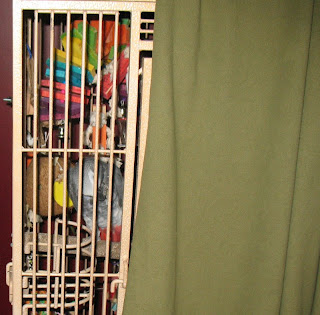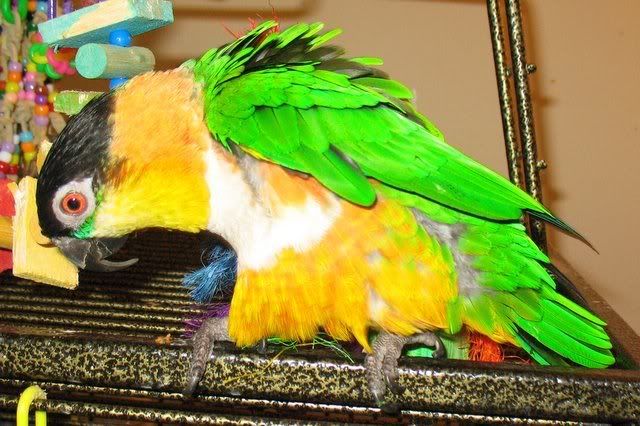He has what amounts to three basic levels in his cage -- a high perch where he spends most of his time, middle perches near his food and water dishes, and the floor of the cage. Every time I visited him at the rescue, he was on his highest perch -- it's where he feels safe. At our house, he also spent the majority of his time on his highest perch -- especially in the beginning when he would venture down (usually when we weren't in the room) only for a quick drink or for some food. And then scramble back to his safe, high perch if we happened to enter the room when he was eating or drinking.
I put some of his favorite toys at different levels of his cage to entice him to explore, and it worked -- but only when we weren't there. He'd remain on his top perch in our presence, but I'd find evidence (through toy destruction) that he'd been all over his cage. Recently, he's been spending more and more of his time on the bottom and middle levels of his cage, even when we're there!
I am really excited about this! It shows that he's gaining confidence and isn't as scared of us. Perched on the middle level (you can see his top level rope perch to his upper left):
 In order to entice him down, I placed a perch on the inside of his cage door. Usually I don't like to do this, as my parrots frequently perch on their cage doors and then poop on this perch. Since Steve doesn't perch on his cage door as he is too afraid to exit his cage, I don't have to worry about that!
In order to entice him down, I placed a perch on the inside of his cage door. Usually I don't like to do this, as my parrots frequently perch on their cage doors and then poop on this perch. Since Steve doesn't perch on his cage door as he is too afraid to exit his cage, I don't have to worry about that!In my experience, it can be easier to get a parrot to step off of a perch that's attached to the inside of a cage door than from a perch that's deeper inside their cage. I'm hoping that if Steve gets used to perching here, it might make it easier for us to progress to him stepping up out of his cage.
In the foreground, his perch (which he is already destroying after less than 12 hours in his cage!); in the background, Steve:
 I'm taking things very slowly, though. Right now, I'm praising him and giving him treats (frequently a wrapped pellet -- he just loves those!) just for staying calm on the middle level of his cage. I also hide wrapped pellets in his cage door perch, giving him an incentive for exploration when I'm not there.
I'm taking things very slowly, though. Right now, I'm praising him and giving him treats (frequently a wrapped pellet -- he just loves those!) just for staying calm on the middle level of his cage. I also hide wrapped pellets in his cage door perch, giving him an incentive for exploration when I'm not there.Step one seems to be working, as he was perched here, even with me in the room!
 I do not yet want to open the door and risk freaking him out, but that will come in time, as he gets more comfortable, so it will not be so scary.
I do not yet want to open the door and risk freaking him out, but that will come in time, as he gets more comfortable, so it will not be so scary.I do not cover my birds at night, but I do cover Steve halfway. This is because his cage is near a window, and my neighbors sometimes turn their back light on. I frequently get up early in the morning to run, and don't get the parrots up as they get to sleep until I return.
Steve normally greets me with a whistle but stays on his high, safe, sleeping perch. This morning, he surprised me, as he came down!
 I gave him a pistachio, praised him for being so brave, told him to go back to bed, and went out for my run. When I returned, he was back on his high perch.
I gave him a pistachio, praised him for being so brave, told him to go back to bed, and went out for my run. When I returned, he was back on his high perch.


No comments:
Post a Comment